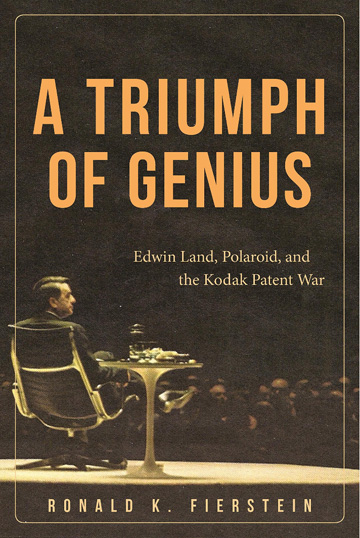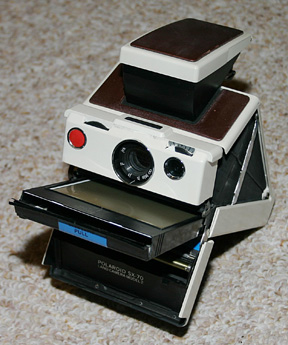
 Entertainment executive Ron Fierstein is venturing down a different path with the release of his new book about Edwin Land, the inventor of the Polaroid camera. Fierstein, also known as the protective older brother of Broadway superstar Harvey Fierstein, shines a deserving spotlight on Land, whose innovation as the father of instant photography ultimately paved the way for another revered visionary: the late Steve Jobs.
Entertainment executive Ron Fierstein is venturing down a different path with the release of his new book about Edwin Land, the inventor of the Polaroid camera. Fierstein, also known as the protective older brother of Broadway superstar Harvey Fierstein, shines a deserving spotlight on Land, whose innovation as the father of instant photography ultimately paved the way for another revered visionary: the late Steve Jobs.
Fierstein’s successful career in artist management included work with notables Suzanne Vega, Shawn Colvin, Mary Chapin Carpenter and Terri Clark. Prior to that, he had a successful career in law which led him to Land’s story. With the recent release of his book, A Triumph of Genius: Edwin Land, Polaroid, and the Kodak Patent War, Fierstein tells MusicRow he is checking off an item on his “bucket list”—which was to research and write about Land’s incredible story of technological innovations.
MusicRow sat down with Fierstein to discuss the book, his famous brother and why everyone should know Edwin Land’s name.
Before transitioning into the music business, how did your career in law begin?
I always wanted to be in entertainment but decided law school would be more practical. I went to law school to get a background to take into the music business. I went to the best New York firm in intellectual property, Fish & Neave, expecting to work on copyright and trademarks which would be relevant to the entertainment business. When I got there, I found out they mostly did patents because that was the lucrative part of intellectual property law. I ended up working on the famous Polaroid Kodak lawsuit and it was a fantastic experience. Law was a bit of a diversion, but I use my legal background everyday in my entertainment career.
During your entertainment career, you went through Nashville’s Leadership Music program. How was that experience?
Leadership Music was fantastic! I was so impressed with that organization and still am to this day. What I love about Nashville is the sense of community and the people. The Leadership Music component really created that sense of community for me. I love its dedication to learning and sharing experiences in the different areas of the music business. I haven’t seen anything like it anywhere else.

The original cast of “Kinky Boots.” Photo: Facebook.com/KinkyBootsBway
And speaking of community, describe your strong bond with your brother, Broadway’s Tony Award winner, Harvey Fierstein.
I’m very close to my brother. He’s my little brother and I’ve been looking after him since we were teenagers in the sense of “him against the world.” When we were teenagers, he came down to dinner one night and announced to my parents that he was gay, although in those days, the term was “homosexual.” I’ve been out front, looking after him ever since, and now in a more professional way since I handle of all of his business and legal affairs. Harvey’s been proclaiming the message, “I am who I am,” since the ‘80s. I’m also co-producer of the musical, Kinky Boots and its message is really important. It started with Torch Song Trilogy and Kinky Boots is the latest embodiment of that message.
After all of your experience in the entertainment industry and working with your brother, you set out to write a book about inventor and scientist Edwin Land. What is the theme of A Triumph of Genius?

Ron Fierstein
Actually, there are two themes of the book. One is Land and his story because he is a tremendously interesting guy. The second is the relationship between Polaroid and Kodak which is almost like an opera in the sense that the companies started out as mentor and protege and ended up arch enemies over 60 years.
In the beginning Polaroid was just selling plastic polarizers which were used to make camera filters. This was Land’s first invention at only 19 years old! When Polaroid got into photography, Kodak manufactured the negative for every Polaroid film used. By the mid ‘60s, Polaroid was Kodak’s second largest customer, second only to the cigarette manufacturers as Kodak made little plastic tubes that were made into cigarette filters. The companies had a very successful and beneficial relationship until 1968, when Land showed his friends at Kodak the prototype of what was to become the SX-70, the Polaroid camera and film that most people are familiar with. The picture comes out of the camera and it develops in your hand. All the previous generations involved a peel-apart technology which required coating the print with a chemical to stabilize it. When Land showed his invention to Kodak, Kodak knew they might lose around $6 billion in film sales over the next 10 years and ultimately, the companies went their separate ways.
How did that result in you establishing a relationship with Land?

SX-70 Model 2 with film cartridge protruding from the front. Photo: Wikipedia
In 1972, Polaroid put out their SX-70 camera and film. In 1976, Kodak came up with their own camera. It used a lot of Polaroid technology and Polaroid owned the patents. Polaroid was forced to sue Kodak for patent infringement and Kodak was found guilty and liable for infringing on seven Polaroid patents, three of which Land was the inventor.
The firm I worked at had around fourteen lawyers on the case and at some point, Land sort of picked me out of the group of young lawyers buzzing around Polaroid. I was selected to be the guy who dealt with him directly, spending a lot of time with him and helping him prepare for the trial. Kodak ultimately had to pay Polaroid almost a billion dollars in damages and they had to take their cameras and film out of the stores. Even though there were 13 million Americans who had Kodak instant cameras in their homes, the court still ordered Kodak to get out of the business and those customers were left high and dry with cameras without any film.
Why was it so important for you to tell Edwin Land’s story?
Land was the most impressive, amazing inventor and technology entrepreneur, but no one has ever heard of him. From WWII until President Gerald Ford, he worked for seven American Presidents doing top secret intelligence work. He was responsible for so many things: the U-2 spy plane, the camera that Neil Armstrong walked on the moon with, the CORONA, the nation’s first photo reconnaissance satellite, and the Polaris missile launching site. All of these, he did in total secret, taking advantage of America’s technology, marshalling the resources and bringing these things to reality. His life story is incredible. He was a little bit of a recluse and had all of his personal papers destroyed when he died.
Can you tell me about the relationship between Steve Jobs and Land?
Steve Jobs admitted he idolized Land. During the beginning of his career, Jobs did an interview and went on and on about Land and how he modeled his career after him. It’s well known that Steve Jobs would introduce his new products to his shareholders from a stage. Land was doing that 30 years before him. Land introduced the SX-70 in 1972 to the Polaroid shareholders sitting on a desk chair with a Saarinen Tulip table to his right. If you Google Steve Jobs and look for images, you’ll find a picture of Steve Jobs sitting on the chair in front of the Apple shareholders with that same exact table to the right of him when he was introducing the iPad. Tim Cook has said that Apple’s role in life is to give you something that you didn’t know you wanted. Cook obviously continued that from Steve Jobs. Steve Jobs got that from Edwin Land. That was Edwin Land’s credo. He would say, “My job is not to ask the public what they want. My job is to give them what they can’t even imagine.” Edwin Land was the original Steve Jobs. There’s no doubt about it.
To purchase A Triumph of Genius, click here.

Category: Exclusive
About the Author
Sherod Robertson is President and Owner of MusicRow Enterprises. He oversees all operations and develops strategic initiatives for MusicRow magazine, RowFax, and MusicRow's CountryBreakout chart. Robertson previously served as Director of Finance of Arista Records after beginning his career as Vice President of Finance and CFO at Reunion Records.View Author Profile


